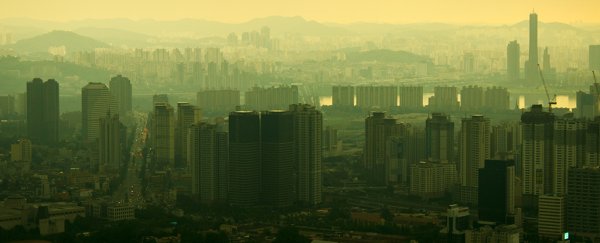Air pollution is a major problem no matter where you live, but it can get particularly bad in Seoul, the capital of South Korea – and so the government authorities are taking drastic action to try and deal with the smog that settles over the city.
The latest plan from President Moon Jae-in is to create artificial rain showers to effectively wash the air pollution out of the sky. It's a strategy we've seen before, but there's still no solid evidence that it actually works.
The idea is called cloud seeding: specific chemicals are released into the air, usually by planes, with the intention of encouraging water droplets to form. The rain that's created then attracts and pulls polluting aerosol particles out of the sky as it falls.
That's the theory, anyway. Previous experiments have been inconclusive as to whether cloud seeding actually works, and South Korea itself made a failed attempt to force air-clearing showers back in January.
So far the technique has been used to try and ensure good weather for the Beijing Olympics and to solve water shortages, but specific types of clouds have to be present to begin with in order to give precipitation an artificial boost.
Aside from cloud seeding, there's also an ongoing debate about the long-term effectiveness of using water to clear away pollution. Rain can clear the air of polluting particles, but to what extent and how effective it can be is something scientists are still investigating.
Nevertheless, South Korea is going to give it another go. The project is being undertaken in partnership with China, as a lot of the fine dust particles clogging up the atmosphere are originating from the neighbouring country.
Apparently the artificial rain showers will be generated above the Yellow Sea, to the west of the Korean Peninsula.
It's been a particularly bad week for air pollution in the region. The Associated Press reports that fine dust concentration levels were 136 micrograms per cubic metre in Seoul on Wednesday – with 75 micrograms per cubic metre considered "very bad" by the National Institute of Environmental Research in South Korea.
That's in relation to ultrafine particles smaller than 2.5 micrometres in diameter, or PM 2.5. The World Health Organisation (WHO) recommends keeping PM 2.5 levels below 25 micrograms… so you can see the severity of the problem.
The government is also taking steps to close down older coal-burning power plants, and to make more money available for air purifiers in schools.
Whatever the effectiveness or otherwise of using artificial rain to clear away pollution, what's clear is that action needs to be taken, and fast. According to WHO stats released last year, 93 percent of kids worldwide under 15 are breathing polluted air.
Ultimately, combating air pollution in the long term – and all the damage to our health and the natural world that goes with it – is going to involve changes in the way we live and produce our energy.
